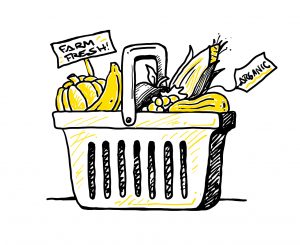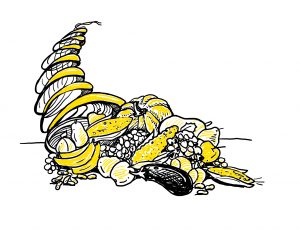An Everyday DNA blog article
Written by: Sarah Sharman, PhD, Science writer
Illustrated by: Cathleen Shaw
As I write this blog post, I daydream about the Thanksgiving feast that awaits me on Thursday. I’ve actually been thinking about Thanksgiving food since I flipped my calendar to November, if we’re being honest. There’s just something about gathering with family to enjoy a delicious meal that warms my heart.
Our table will be filled with turkey, ham, mashed potatoes, sweet potato casserole, cornbread dressing, green beans, and the ever-controversial giblet gravy, a family tradition. Once I move past my initial drooling over the meal, my inquisitive mind wonders how different thanksgiving meals of yore looked and tasted. 
According to written accounts from the first several American thanksgivings, the meal likely consisted of duck, venison, or seafood, with cabbage, onions, corn, pumpkins, and squash for the sides. Although we have some of the same foods on our Thanksgiving tables today, they are likely vastly different from those our ancestors harvested. Natural climate adaptation, human intervention, and technological advances leave us with genetically different crop plants. Let’s learn more about how fruits and vegetables have changed over the centuries since the first thanksgiving feast.
Human migration changed the thanksgiving plate again and again
Humans have always moved plants around with us, intentionally or not. Ancient hunter-gatherers often dropped seeds from fruits they were eating while they were scouting out new hunting grounds. Once humans began migrating to other countries and continents, they brought plants with them to the new worlds and returned home with native plants. This is how the potato, native to Peru, became a staple crop in Western and Northern Europe, and sugarcane became a sweet addition to the diet in the Americas.
Early farmers were genetically manipulating crops, even if they were unaware of it at the time. At the end of every harvest, farmers saved seeds from the most productive, most successful, or tastiest plants in their gardens. This is how they unknowingly selected the genetically elite plants, even though DNA wouldn’t be discovered for centuries. Planting and breeding the best plants together for the next growing season allowed farmers to create the most suitable crops for the weather and land in which they were growing. This helped them meet the demand for feeding, clothing, and sheltering their people.
 In addition to serving as dietary staples, crops also turned into sources of revenue for early Americans. Europeans brought plants like sugar and coffee from Asia to grow as cash crops in America and turned native crops like tobacco and cacao into profit makers. The economic reliance on plants was intensified when colonists learned that growing large numbers of the same crop on plantations provided a bigger return on investment. Global trading networks found European merchants selling American-grown cash crops worldwide, greatly speeding up the global transfer of new foods.
In addition to serving as dietary staples, crops also turned into sources of revenue for early Americans. Europeans brought plants like sugar and coffee from Asia to grow as cash crops in America and turned native crops like tobacco and cacao into profit makers. The economic reliance on plants was intensified when colonists learned that growing large numbers of the same crop on plantations provided a bigger return on investment. Global trading networks found European merchants selling American-grown cash crops worldwide, greatly speeding up the global transfer of new foods.
As Americans migrated further west, they took crop plants with them, exposing the plants to new climates and environments they’d never encountered before. Plants that survived these changes adapted genetically, containing new versions of genes that confer beneficial traits like cold hardiness, drought tolerance, or pest resistance.
Corn is a fascinating example of a plant that underwent many genetic changes over its lifetime due to human intervention. By sifting through historical records, archaeological remains, and genetic data, researchers determined that maize split off from teosinte grass about 9,000 years ago. Teosinte does not look much like the corn we know today, having much smaller kernels and a hard outer casing that makes it hard to consume without brute force. A teosinte ear is only two to three inches long with about a dozen kernels, whereas today’s corn ears average about 12-inches with 500 or more kernels.
Over several thousands of years, our ancient ancestors bred teosinte to select desirable traits, including improving the ears and kernels. They capitalized on random mutations that eliminated less desirable traits like the hard outer casing, saving seeds from these mutants and breeding them with other elite plants the next growing season. A genetic study found that of the 59,000 total genes in the corn genome, approximately 1,200 were preferentially targeted for selection during its domestication.
Technological advances 
As the world population grew exponentially, farmers needed to feed far more people than ever before. Discovering ways to increase productivity while maintaining quality, taste, and economic value became an important goal in the agricultural field. Many natural and synthetic means for increasing crop production were developed, leaving farmers with many choices when determining how to treat and farm their crops. Today, a trip to the grocery store’s produce section can be like deciphering a science textbook with all of the options available: organic, GMO, farm fresh, non-GMO, and the list goes on.
Fertilizers and pesticides
Farmers have used fertilizers to enhance crop growth for thousands of years. Historical records show that Egyptians, Romans, Babylonians, and early Germans all used minerals and manure to fertilize their fields. Travel records from early English settlers in America indicate that Squanto taught them how to use fish to fertilize their fields. Current fertilizer practices, however, are relatively recent, dating back to the last half of the 20th century.
When crops are harvested, important nutrients are removed from the soil within the plant itself. Fertilizers help replenish the soil by adding back important nutrients and chemical elements. Synthetic fertilizers increased the volume of crops that can be grown on a fixed amount of land. However, overusing synthetic fertilizers can decrease soil fertility and leech into nearby water sources.
In addition to healthy soil and plentiful water, a successful harvest also depends on protecting crops from infection and invasion by bugs, fungi, and other plants like weeds. Mankind used pesticides to protect their crops for centuries, with one of the earliest documented cases being the application of fungicides in the eighth century BC. The widespread use of chemical pesticides in the U.S. began after World War II. Chemical pesticides help farmers mitigate crop loss from various pests.
Organically grown produce means natural fertilizers and pesticides were used instead of synthetic chemicals. Examples include compost and manure instead of chemical fertilizers, birds and traps instead of synthetic pesticides, and crop rotation, mulching, and hand weeding instead of synthetic herbicides. Organic produce must be grown without genetic engineering or modification.
Genetic engineering
Genetically modified organisms (GMO) are engineered in a lab to have desirable new characteristics that they do not naturally carry. This might mean resistance to certain pests, faster growing time, larger fruit, higher content of certain vitamins, or resistance to chemical herbicides. In the United States, many GMO crops are genetically engineered to produce their own pesticides or withstand herbicides that would normally kill them. Soy, canola, and corn are the three food crops in the US that are most likely to be genetically modified.
Genome-directed breeding
 Growing populations and changing climates shaped agricultural practices throughout history. Today, there is grave stress being placed on farmers who must not only produce food for an unprecedented number of people but also change their farming practices to keep up with our quickly warming earth. Some of the tools in farmers’ toolkits are more harmful to our environment than helpful. Scientists are working together with farmers and crop breeders to identify alternative ways to create crops that can withstand all of the pressures they are facing.
Growing populations and changing climates shaped agricultural practices throughout history. Today, there is grave stress being placed on farmers who must not only produce food for an unprecedented number of people but also change their farming practices to keep up with our quickly warming earth. Some of the tools in farmers’ toolkits are more harmful to our environment than helpful. Scientists are working together with farmers and crop breeders to identify alternative ways to create crops that can withstand all of the pressures they are facing.
Remember how our ancestors would save the seeds from desirable plants for the next season? Scientists can now look at the plant’s DNA and identify the gene or gene variant that is responsible for desirable traits. The beneficial traits can be introduced into existing crop lines using accelerated breeding programs or precision genome editing. In this way, they can maximize positive genetic traits to produce plants that can withstand pressure from the global spread of plant diseases and pests, dwindling natural resources, climate change, and the booming global population.
Researchers at the HudsonAlpha Institute for Biotechnology Center for Plant Science and Sustainable Agriculture are experts at sequencing and analyzing plant genomes to identify genetic contributors to agriculturally important traits. Members of the Plant Center are part of a collaborative effort to create new crops tailored to grow better in Alabama’s climate and soil conditions. Agronomists at Auburn University and Alabama A&M University planted diverse types of barley at field stations across the state. They identified barley plants that had more desirable traits or grew better than others. In the future, DNA from the barley plants can be used to analyze relationships between genetic variation and phenotypic traits to select lines for improved breeding in Alabama.
The barley types that are selected as potential candidates for the best growth in Alabama will be planted at collaborating farms throughout the state. Their production and success will be monitored throughout several growing seasons. Eventually, the best barley varieties will be released to farmers to grow on their land. In addition to offering local farmers a new crop to grow, the locally-sourced Alabama barley will also benefit local breweries and restaurants.


